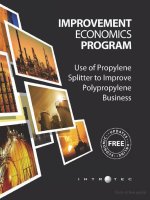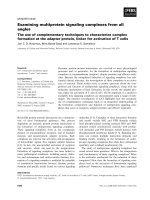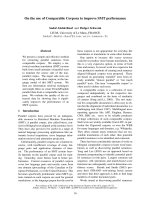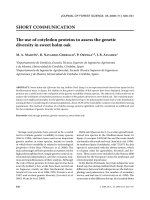Financial planning – the use of quantitative indicators to make a business decisions
Bạn đang xem bản rút gọn của tài liệu. Xem và tải ngay bản đầy đủ của tài liệu tại đây (345 KB, 29 trang )
9.3 Financial Planning –
the use of
quantitative indicators to make a business decisions
9.3.1 Decision Trees
9.3.2 Investment Appraisal
9.3.3 Break-even (n.b. this is not covered
in this presentation)
9.3.2 Investment Appraisal
• A means of assessing whether an
investment project is worthwhile or
not
• Investment project could be the
purchase of a new PC for a small firm, a
new piece of equipment in a
manufacturing plant, a whole new
factory, etc
• Used in both public and private sector
Investment Appraisal
• 3 methods of
investment
appraisal:
– Payback Period
– Accounting Rate
of Return (ARR)
– Net Present Value
(discounted cash
flow)
What factors need to be considered before
investing in equipment such as this?
Copyright: Gergely Erno, stock.xchng
Investment Appraisal
• Why do companies invest?
– Importance of remembering investment as the
purchase of productive capacity NOT buying stocks
and shares or investing in a bank!
• Buy equipment/machinery or build new plant
to:
– Increase capacity (amount that can be produced)
which means:
• Demand can be met and this generates sales revenue
• Increased efficiency and productivity
Investment Appraisal
A fork lift may be an important item but
what does it contribute to overall sales?
How long and how much work would it have
to do to repay its initial cost?
Copyright: Loisjune, stock.xchng
• Investment therefore
assumes that the
investment will yield
future income
streams
• Investment appraisal
is all about assessing
these income
streams against the
cost of the
investment
• Not a precise
science!
Method 1 Payback Period
Payback Method
• The length of time taken to repay
the initial capital cost
• Requires information on the revenue
the investment generates
• e.g. A machine costs £600,000
• It produces items that sell at £5 each
and produces 60,000 units per year
• What will the Payback period be ?
This method assumes that the cash
inflow will be constant every year.
Payback method
• Payback could occur during a year
Initial Investment
Payback = -----------------------------------------Total Cash Received
=
600,000
(5 x 60,000)
= 2 (years)
Can take account of this investment
by reducing the cash inflows from
the investment over a number of
years
• e.g.
– Cost of machine =
£600,000
– Annual income
streams from
investment =
£255,000 per year
• Payback = 36 x
600,000/765,000
– = 28.23 months
– (2 yrs, 4 1/4 months)
Payback Method
Income
Year 1
255,000
Year 2
255,000
Year 3
255,000
Payback Method with uneven cash
inflow
• e.g.
– Cost of
machine =
£450,000
• Payback =
Income
Year 0
(£450,000)
Year 1
£50,000
Year 2
£70,000
Year 3
£100,000
Year 4
£130,000
Year 5
£200,000
Cumulative
Cash flow
Payback Method with uneven cash
inflow
• e.g.
– Cost of
machine =
£450,000
• Payback =
4.5 years or
4 years 6
months
Income
Cumulative
Cash flow
Year 0
(£450,000)
Year 1
£50,000
(400,000)
Year 2
£70,000
(330,000)
Year 3
£100,000
(230,000)
Year 4
£130,000
(100,000)
Year 5
£200,000
100,000
Method 2
Accounting Rate of Return
(aka Average Rate of Return)
Accounting Rate of Return
• A comparison of the profit
generated by the investment with
the cost of the investment
Average annual return or annual profit
•
ARR = -------------------------------------------- x 100
Initial cost of investment or Capital Outlay
Accounting Rate of Return
• For example:
• An investment is expected to yield cash flows
of £10,000 annually for the next 5 years
• The initial cost of the investment is £20,000
• Total profit therefore is: £30,000 calculated by
(5x£10,000)-£20,000
• Annual profit = £30,000 / 5
= £6,000
ARR = 6,000/20,000 x 100
= 30%
A worthwhile return?
Activity
•
on ARR
Clinton Construction is considering 2 projects. Using the ARR approach decide
which is the better investment.
Project A
Project B
Initial investment
-£10,000
-£20,000
Year 1 cash receipt
£4,000
£9,000
Year 2 cash receipt
£5,000
£9,000
Year 3 cash receipt
£5,000
£12,000
Year 4 cash receipt
£4,000
£10,000
Total cash receipt (1)
Profit over 4 years (2)
Average annual profit (3)
Accounting Rate of
Return (4)
Space for calculations
Activity on Accounting Rate of Return
•
Clinton Construction is considering 2 projects. Using the ARR approach decide
which is the better investment.
Project A
Project B
Initial investment
-£10,000
-£20,000
Year 1 cash receipt
£4,000
£9,000
Year 2 cash receipt
£5,000
£9,000
Year 3 cash receipt
£5,000
£12,000
Year 4 cash receipt
£4,000
£10,000
Total cash receipt
£18,000
£40,000
Profit over 4 years
£8,000
£20,000
Average annual profit
£2,000
£2,000 X 100
£5,000
£5,000 X 100
£10,000
£10,000
Accounting Rate of
Return
20%
25%
Investment Appraisal
• Key considerations for firms in
considering use:
– Ease of use/degree of simplicity required
– Degree of accuracy required
– Extent to which future cash flows can be
measured accurately
– Extent to which future interest rate
movements can be factored in and
predicted
– Necessity of factoring in effects of inflation
Investment Appraisal
• To make a more
informed decision,
more sophisticated
techniques need to
be used.
• Importance of the
value of money over
a period of time.
Some
examples
fromBiz-ed
Net Present Value (NPV)
Net Present Value
• Takes into account the fact that money values
change with time
• How much would you need to invest today to
earn x amount in n years time?
• Value of money is affected by interest rates
• NPV helps to take these factors into
consideration
• Shows you what your investment would have
earned if it was investment in something else
Net Present Value
• e.g.
• Project A costs £1,000,000
• After 5 years the cash returns =
£100,000 (10%)
• If you had invested the £1 million into a
bank offering interest at 12% the
returns would be greater
• You might be better off re-considering
your investment!
Net Present Value
• The principle:
• How much would you have to invest now to earn £100
in one year’s time if the interest rate was 5%?
• The amount invested would need to be: £95.24
• Allows comparison of an investment by valuing cash
payments on the project and cash receipts expected to
be earned over the lifetime of the investment at the
same point in time, i.e the present.
• Process referred to as:
‘Discounting Cash Flow’
Net Present Value
NPV =Cash flow x discount factor
• e.g. NPV of £500 in 10 years time at a
rate of interest of 4.25%
= 500 x 0.6595 = £329.77
Discount
factor is
looked up
in a table
• £329.77 is what you would have to
invest today at a rate of interest of
4.25% to earn £500 in 10 years time
The discount factor can be found through valuation
tables (e.g. Parry’s Valuation Tables)
Discounted Cash Flow
• An example:
• A firm is deciding on investing in an
energy efficiency system. Two possible
systems are under investigation
• Both cost £600,000 and they both have
the same cash flow after 6 years.
However, one yields quicker results in
terms of energy savings than the other
but the second may be more efficient
later on.
• Which should the firm invest in?
Net Present Value (NVP) – System A
Year
Cash Flow (£)
Discount Factor
(4.75%)
Present Value
(£)
(CF x DF)
0
- 600,000
1.00
-600,000
1
+75,000
0.9546539
71,599.04
2
+100,000
0.9546539
3
+150,000
0.9113641
4
+200,000
0.8700374
5
+210,000
0.8305846
6
+150,000
0.7929209
Total
Key:
NPV
=
CF = Cashflow; DF = Discount Factor; NPV = Net Present Value









